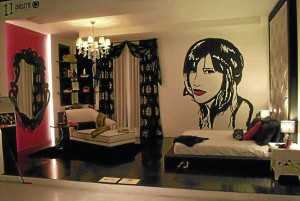
The 91 graduating students of the Philippine School of Interior Design’s advance class took us back to our childhood days, as they mounted 20 sustainable designs in “Jak en Poy (Bato, Gunting, Papel, atbp.): An Interior Design Exhibit of Sustainable Proportions.”
Having created interior spaces made of 60 percent of any of 10 materials—stone, steel, concrete, paper, glass, wood, bamboo, rubber, plastic and clay—each of the 20 groups had a story to tell, well worth the stress and sleepless nights.
“We had a hard time sourcing for rubber,” says Shane Tomelden of her group’s “Chiclette,” a neo-baroque bedroom, inspired by the concept of rubber-based gum.
It took Tomelden’s group two weeks to scour for possible suppliers––they were way behind construction schedule. They finally came up with a mural of rubber sheets and a lovely space combining both beauty and function.
It had been a similar story for “Glass with Class,” a Cleopatra-inspired modern Egyptian bedroom. It used 80-percent glass for the walls, floor, and furniture pieces.
“We went as far as Pampanga and Central Luzon searching for the cheapest yet quality glass material,” says Katrina de Leon.
And how creative do you think designers’ imaginations can get?
Without compromising durability and recyclability, Rico Urbano and his co-designers defied convention in utilizing an aircraft wing for a table. They used bottle caps as decorative pieces; an accent wall in a peacock tail-inspired dining area is called “De Hierro Pavo Real.”
Ingenious materials
A curtain in copper chains, a ceiling fixture made of copper wires, and panels in copper sheets are what made “Boho Glam,” an eclectic bedroom made of 100-percent recycled copper unique.
“Bamboozled,” a bathroom made of bamboo, featured different applications of bamboo as divider, wood parquet, and a do-it-yourself chandelier. What was striking, though, was the simulation of a glass wall made of acrylic, which, according to designer Aivan Magno, was “super expensive.”
The designers of “Paper View” initially feared failure. They created a sustainable living room, made of old newspapers and magazines to create texture on plain surfaces. Toilet paper tubes were used for wall paneling; used shredded paper from old documents and bills were used for throw pillows and cardboard box of accessories.
Designers Jenny Wong and Ethel Quijano of “Ecotechnowood,” a bathroom made of recycled plywood and wood scraps that featured sawdust as accent element, said providing the wood was easy. It was designing the toilet and bath that was the most challenging part of their design.
What goes on behind job sites means getting down and dirty to work. Sure, the finished products made it all look easy, but what happens behind the scenes is not ordinary.
“Some of us had fallen ill but continued manning the construction,” revealed Gelsey Uy, a co-designer of “Yin and Yang: Equilibrium in Nature,” a modern rendition of a bathroom featuring a lot of opposites. Crafted into attractive screen panels and artistic mosaic tiles were discarded plastic hoses in acrylic or polymer.
Creative spaces
Other interior spaces included “Wonder Grass,” an eco-friendly kitchen that used bamboo slats for its wall, ceiling and accent lighting; “Tangible Dream,” concrete bedroom with gothic details and whimsical elements; “Nouvelle Vie,” Scandinavian dining room fusing natural and synthetic with the use of recycled PVC pipes; “Eat ’To Bato,” cave-inspired dining room; “Looking Glass,” Crystal Palace-inspired living area made mainly of recycled glass; “Rockusina,” kitchen featuring stone boulders, sleek metal cabinets, and polished finishes; and “Le Boudoir Rose,” romantic living room.
“Flight of Imagination” is a Spring-inspired modern kitchen; “Glamorous Green,” a toilet and bath made of repossessed clay bricks, broken, or rejected ceramic tiles made into mosaic pieces; “Lastico,” dining room with a wall made of rubber sheets, with Chinese garters accentuating the ceiling; “Three to Tango,” living room made of clay divided into a conversation area, a writing desk, and a reading nook; and “Out of the Box,” an eclectic kitchen highlighting cabinets made mostly of cardboard.
“We had months of preparation,” said batch president Peaches de Guzman, though it took them one month and a week since August for the construction. “We had a lot of fundraising activities to cover the general venue.”
The class also partnered with WE International Philippines, a SEC registered NGO that raises awareness and provides sustainable ways to respond to poverty in the Philippines by facilitating economic development through education projects, micro-lending, environment initiatives, and sustainable business development services.
“Not only did we learn about technicalities,” De Guzman said. “We bonded together as a group, as we learned to compromise and design with a conscience,” she added.